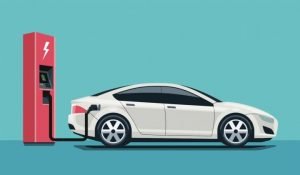Electric Cars
The Plug-in hybrid vehicles consists of an electric battery that needs to be charged once in a while, as well as the gasoline and diesel engine which needs to be filled in frequently. Whereas the battery electric cars completely work on electricity. Electric cars are a lot more expensive than the conventional cars but they have a lower cost of ownership and maintenance. Driving or using an electric car means, you are saving approximate of €700 a year in the fueling costs!
Key Components of Electric Cars
Almost all electric vehicles are composed of these key components:
- Battery
Battery is the first and utmost component of electric motor as it provides electricity to the power vehicle accessories.
- Charge-port
The vehicle can connect to the external power supply through a charge port.
- DC/DC converter
This component is basically used in the conversion of higher voltage DC power to lower voltage DC power using the traction battery pack.
- Electric traction motor
This is used in driving the vehicle or the car’s wheels, using the electric traction battery.
- Onboard charger
The onboard charger helps in monitoring the characteristics of the battery: voltage, temperature check and current.
- Thermal system
This system helps in maintaining the temperature range of the vehicle.
- Traction battery pack
Traction battery back is the significant component of the electric vehicle and is used to store the electricity for use by the vehicle.
- Power electronic controller
The power electronic controller helps with the flow of electrical energy and the torque that it produces.
- Transmission
This helps in transferring the mechanical power to the wheels of the vehicles so that the vehicle can start driving.
Pros of Electric Cars
Low Maintenance and High Performance
As mentioned above, electric vehicles have a very high performance with little to almost no fuel in them. Because they work on the battery, they don’t require diesel or gasoline filled up frequently. The drive of these vehicles is very smooth and quiet. They use almost 70% lesser fuel than the conventional vehicles.
Energy Efficient Cars
Comparatively, Electric vehicles are far more efficient and cost friendly than the conventional cars. These cars batteries are so powerful that they can convert 59 to 62 percent of energy into vehicle movement whereas the gas powered vehicles can only convert 17 and 21 percent energy.
Electric Cars Reduce Emissions
Since these cars relies on the batteries and not completely on the fuels, they help in reducing the emissions. This is one another pro of electric vehicles. These vehicles helps in reducing the overall pollution and dirt in the environment which is being build up from years. With the increase in the number of conventional cars, the percentage of pollution has also been on an increase. Much less fuel is used in these electric vehicles and because of this all the energy is sourced for domestic purposes.
Cons of Electric Cars
Like conventional cars, these electric vehicles also have their advantages as well as disadvantages. With the advantages been discussed already, the disadvantages should be brought in consideration now.
Electric Cars Covers Less Distance
Electric cars travel very less than the convenience cars. Most of the models travel between 60 to 120 miles per charge whereas the luxury models can travel upto 300 miles only. Whereas the gas and diesel fueled vehicles can cover great miles of distances without providing any inconvenience. So the Electric cars are not very suitable to be taken on long trips of long journeys.
Electric Cars Take Longer to Refuel
Electric cars take a lot of time in refueling their batteries. It can take up to hours sometimes and this can be a hasale for the owner of the car. These cars are not very convenient to take them on long distance travels. The owners or the drivers of these cars have to plan more carefully than the convenient car drivers. This is because if these cars run out of power, this cannot be solved in a gas pump easily.
Electric Cars Are Very Expensive
These cars are more costly than the convenient cars and you might have to replace the battery more than in the lifetime of the car. You can assess the electric and then compare it with your needs and interests and then invest in it. Since its expensive with own set of pros and cons, one would likely want to study about these cars before investing in them.







